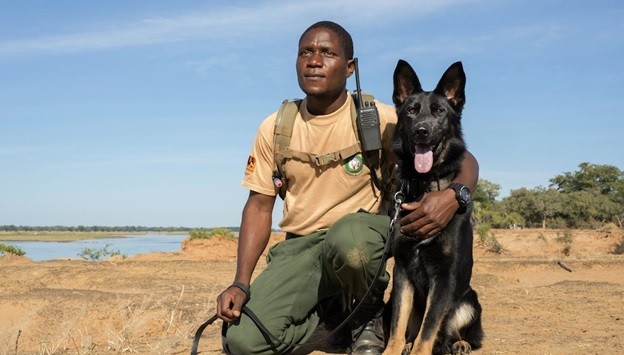
September 2017—Wildlife crime is on the rise throughout sub-Saharan Africa and, with over 20 national parks and 34 game management areas, Zambia is not immune. Accounting for over 7 percent of the country’s gross domestic product, Zambia’s tourism industry is under threat from poaching and illegal wildlife trafficking.
In May 2016, USAID, through its Community Forests Program, funded the introduction of the canine detection (sniffer) unit, which has since delivered impressive results in the Lower Zambezi National Park.
The park forms part of a globally significant trans-frontier conservation area that includes Angola, Botswana, Namibia, Zimbabwe and a UNESCO World Heritage site. The park is home to over 23,000 elephants—one of Africa’s largest populations—as well as rare and endangered species such as eland, pangolin, roan antelope and sable.
The dog unit, with its state-of-the-art facilities, provides a grassroots level, first-line response to combat wildlife crime and poaching. Complete with dogs, handlers and a new modified 4x4 vehicle, the unit traverses the region’s highways to detect criminal activity and poachers, and to disrupt the flow of illegal wildlife. The unit is managed through a partnership between Conservation Lower Zambezi and the Zambian Department of National Parks and Wildlife.
USAID also funded the initial three-month intensive training program for the dogs and their four handlers, who were drawn from the local community. The highly trained detection dogs have imprinted on the scent of ammunition, bushmeat, ivory, pangolin and weapons such as rifles. The dogs have made border crossings and routine checkpoints far more efficient and have led to increased arrests, recoveries and deterrence related to wildlife crime and trafficking. The training was conducted by Invictus K9.
“It's amazing to see how quickly and efficiently these dogs can locate illegal objects,” said USAID economic development officer Jeremy Boley. “Sniffer dogs teams are a key tool in the combating wildlife trafficking toolbox. They are essential to efficiently detecting illegal objects at checkpoints.”
To date, the sniffer dog teams have successfully detected illegal firearms and ammunition, pieces of ivory, leopard skins, live animals, and over 175 kilos of illegal bushmeat. The dog units have also helped track down and apprehend 23 suspected poachers. In upcoming sessions, the dogs will be trained to recognize the scent from rhino horn and Zambia’s rare Mukula wood, increasing the team’s repertoire in the fight against poaching and illegal wildlife trafficking in Zambia.
USAID’s Community Forests Program, which runs from 2014 to 2019, is designed to help the Government of the Republic of Zambia reduce carbon emissions from deforestation through natural resource management and reduce poverty through increased smallholder farmer productivity and the development of non-timber forest products such as honey. Implemented primarily in Zambia's Eastern and Lusaka provinces, the program covers over 700,000 hectares of forest, aims to benefit over 10,000 households, and promotes improved forest management activities across 2 million hectares in the Zambezi and Luangwa Valley ecosystems. The program is being carried out in close partnership with the U.S. Forestry Department and the Zambian Department of National Parks and Wildlife.
LINKS
Follow @USAIDZambia, on Facebook, on Flickr, on YouTube







Comment
Make a general inquiry or suggest an improvement.